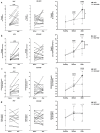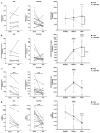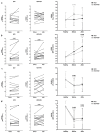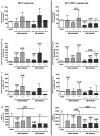Effects of Pegylated Interferon Alpha and Ribavirin (pegIFN-α/RBV) Therapeutic Approach on Regulatory T Cells in HCV-Monoinfected and HCV/HIV-Coinfected Patients
- PMID: 34452314
- PMCID: PMC8402834
- DOI: 10.3390/v13081448
Effects of Pegylated Interferon Alpha and Ribavirin (pegIFN-α/RBV) Therapeutic Approach on Regulatory T Cells in HCV-Monoinfected and HCV/HIV-Coinfected Patients
Abstract
Approximately 25% of HIV-infected patients are co-infected with HCV. Notably, the burden of HCV infection (e.g., viral persistence, viral load, or HCV-related liver symptoms) is more pronounced in the presence of HIV co-infection. However, to date, the underlying immune mechanisms accounting for accelerated disease progression in HIV/HCV-coinfected individuals have not been described in sufficient detail. We hypothesized that regulatory T cells (Treg) bearing potent immunosuppressive capacities could not only play a substantial role in the pathogenesis of HCV/HIV coinfection but also modulate the response to the standard anti-viral therapy.
Materials and methods: To this end, we studied alterations in frequencies of Treg cells in correlation with other Treg-related and virus-related parameters in both HCV and HCV/HIV-infected patients subjected to standard pegIFN-α/RBV therapy.
Results: Notably, we found that pegIFN-α/RBV therapy significantly increased levels of Treg cells in HCV-infected but not in HIV/HCV-coinfected individuals. Furthermore, HIV/HCV-coinfection was demonstrated to inhibit expansion of regulatory T cells during anti-viral treatment; thus, it might probably be responsible for viral persistence and HCV-related liver damage.
Conclusions: Therapy with pegIFN-α/RBV demonstrated a significant effect on regulatory T cells in the course of HIV and/or HCV infection indicating a crucial role in the anti-viral immune response.
Keywords: HCV; HIV; HIV/HCV-coinfection; pegIFN-α/RBV; regulatory T cells.
Conflict of interest statement
The authors declare no conflict of interest.
Figures






Similar articles
-
Critical role of ribavirin for the achievement of early virological response to HCV therapy in HCV/HIV-coinfected patients.J Viral Hepat. 2007 Jun;14(6):387-91. doi: 10.1111/j.1365-2893.2006.00806.x. J Viral Hepat. 2007. PMID: 17501758 Clinical Trial.
-
Ribavirin Concentrations Do Not Predict Sustained Virological Response in HIV/HCV-Coinfected Patients Treated with Ribavirin and Pegylated Interferon in the Swiss HIV Cohort Study.PLoS One. 2015 Jul 28;10(7):e0133879. doi: 10.1371/journal.pone.0133879. eCollection 2015. PLoS One. 2015. PMID: 26218843 Free PMC article.
-
Efficacy and safety of daclatasvir plus pegylated-interferon alfa 2a and ribavirin in previously untreated HCV subjects coinfected with HIV and HCV genotype-1: a Phase III, open-label study.Hepatol Int. 2017 Mar;11(2):188-198. doi: 10.1007/s12072-017-9788-z. Epub 2017 Feb 16. Hepatol Int. 2017. PMID: 28210927 Clinical Trial.
-
Treatment of chronic hepatitis C in human immunodeficiency virus/hepatitis C virus-coinfected patients in the era of pegylated interferon and ribavirin.Semin Liver Dis. 2005 Feb;25(1):33-51. doi: 10.1055/s-2005-864780. Semin Liver Dis. 2005. PMID: 15731996 Review.
-
Therapeutic issues in HIV/HCV-coinfected patients.J Viral Hepat. 2007 Jun;14(6):371-86. doi: 10.1111/j.1365-2893.2006.00816.x. J Viral Hepat. 2007. PMID: 17501757 Free PMC article. Review.
Cited by
-
Combined Effects of Fludarabine and Interferon Alpha on Autophagy Regulation Define the Phase of Cell Survival and Promotes Responses in LLC-MK2 and K562 Cells.Med Sci (Basel). 2022 Mar 17;10(1):20. doi: 10.3390/medsci10010020. Med Sci (Basel). 2022. PMID: 35323219 Free PMC article.
-
Mpox (formerly monkeypox): pathogenesis, prevention, and treatment.Signal Transduct Target Ther. 2023 Dec 27;8(1):458. doi: 10.1038/s41392-023-01675-2. Signal Transduct Target Ther. 2023. PMID: 38148355 Free PMC article. Review.
-
Polyethylene Glycol-Modified Cationic Liposome as a Promising Nano Spray for Acute Pneumonia Treatment.Polymers (Basel). 2024 May 12;16(10):1384. doi: 10.3390/polym16101384. Polymers (Basel). 2024. PMID: 38794576 Free PMC article.
-
Gamma-Delta T-Cell Phenotype and Function in DAA-Treated HIV-HCV Co-Infected and HCV-Mono-Infected Subjects.Viruses. 2022 Jul 22;14(8):1594. doi: 10.3390/v14081594. Viruses. 2022. PMID: 35893661 Free PMC article.
-
The effects of G1899 Korean red ginseng extract powder on long COVID for acute COVID19 infection: A randomized, double-blind, placebo-controlled trial.J Ginseng Res. 2025 Jul;49(4):470-477. doi: 10.1016/j.jgr.2025.04.007. Epub 2025 Apr 24. J Ginseng Res. 2025. PMID: 40621076 Free PMC article.
References
-
- Daar E.S., Lynn H., Donfield S., Gomperts E., Hilgartner M.W., Hoots W.K., Chernoff D., Arkin S., Wong W.Y., Winkler C.A. Relation between HIV-1 and hepatitis C viral load in patients with hemophilia. J. Acquir Immune Defic. Syndr. 2001;26:466–472. doi: 10.1097/00042560-200104150-00011. - DOI - PubMed
-
- Martinez-Sierra C., Arizcorreta A., Díaz F., Roldán R., Martín-Herrera L., Pérez-Guzmán E., Girón-González J.A. Progression of chronic hepatitis C to liver fibrosis and cirrhosis in patients coinfected with hepatitis C virus and human immunodeficiency virus. Clin. Infect. Dis. 2003;36:491–498. doi: 10.1086/367643. - DOI - PubMed
-
- Merchante N., Girón-González J.A., González-Serrano M., Torre-Cisneros J., García-García J.A., Arizcorreta A., Ruiz-Morales J., Cano-Lliteras P., Lozano F., Martínez-Sierra C., et al. Survival and prognostic factors of HIV-infected patients with HCV-related end-stage liver disease. Aids. 2006;20:49–57. doi: 10.1097/01.aids.0000198087.47454.e1. - DOI - PubMed
-
- D’Arminio Monforte A., Cozzi-Lepri A., Castagna A., Antinori A., De Luca A., Mussini C., Caputo S.L., Arlotti M., Magnani G., Pellizzer G., et al. Risk of developing specific AIDS-defining illnesses in patients coinfected with HIV and hepatitis C virus with or without liver cirrhosis. Clin. Infect. Dis. 2009;49:612–622. doi: 10.1086/603557. - DOI - PubMed
MeSH terms
Substances
LinkOut - more resources
Full Text Sources
Medical

